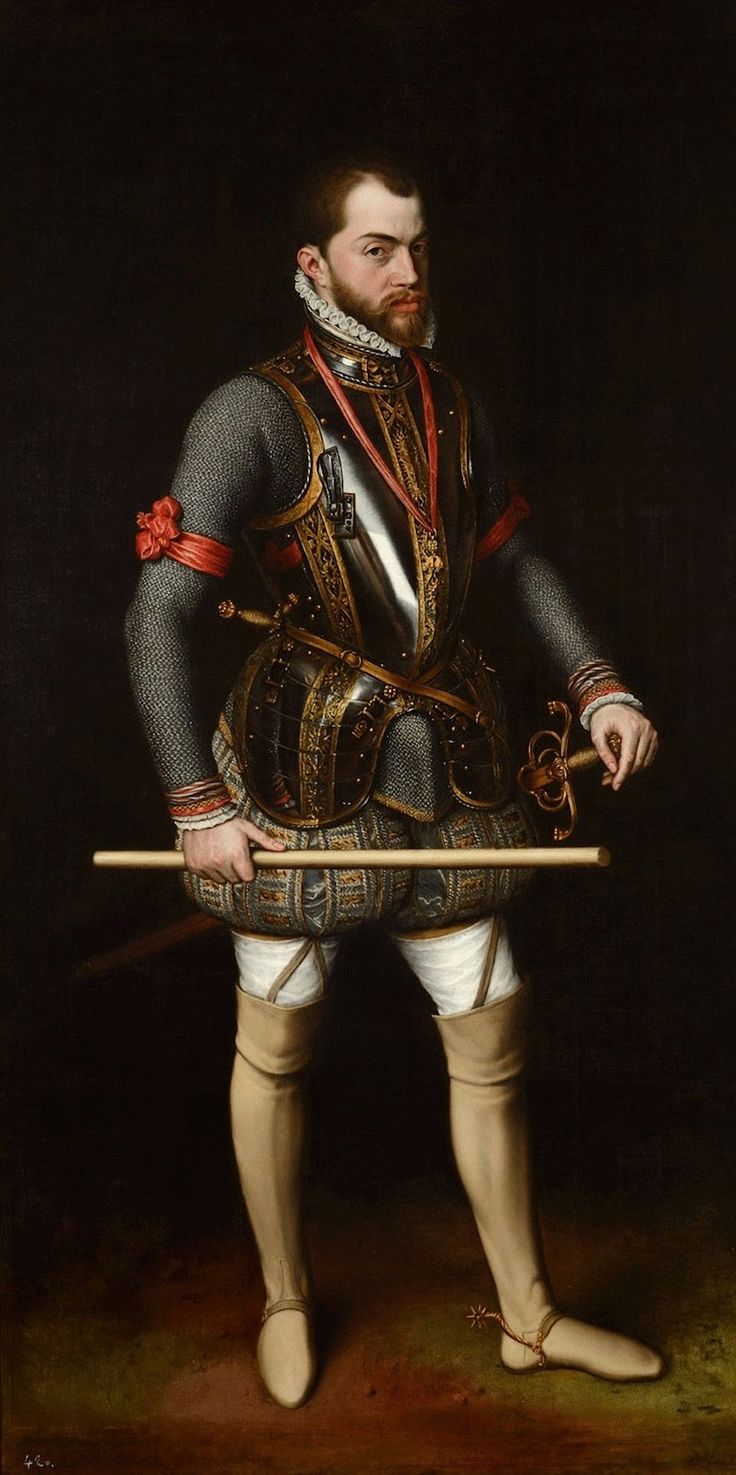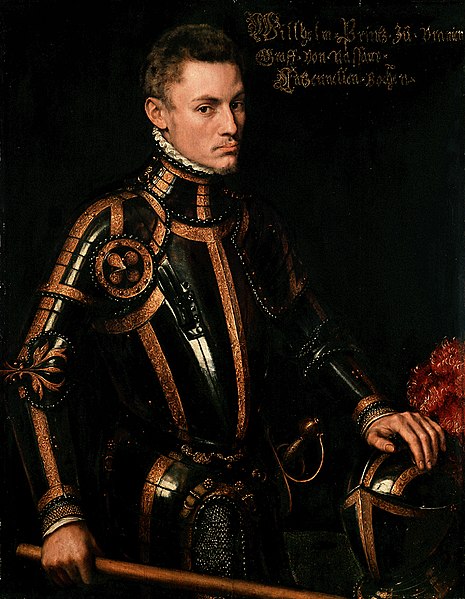| Author |
Message |
Adam D. Kent-Isaac

|
 Posted: Mon 21 Sep, 2009 7:13 pm Post subject: Early-period Tudor armour - what style is this? Posted: Mon 21 Sep, 2009 7:13 pm Post subject: Early-period Tudor armour - what style is this? |
 |
|
Before the Greenwich armoury started producing garnitures like the ones depicted in the Jacob Album, the Tudor noblemen can be seen in dark armours with bold designs of gilded stripes. Is this the early form of Greenwich armour? It seems inspired by German styles. Here are some examples.



Pastime With Good Company
|
|
  |
 |
|
Gregory J. Liebau
Location: Dinuba, CA Joined: 27 Nov 2004
Posts: 669
|
 Posted: Mon 21 Sep, 2009 10:01 pm Post subject: Posted: Mon 21 Sep, 2009 10:01 pm Post subject: |
 |
|
This portrait is of Sir William Hebert, First Earl of Pembroke, and dates to 1560-65. The original garniture is housed in the Glasgow Armoury and can be viewed extensively in Tobias Capwell's book The Real Fighting Stuff. This harness is of a typical design from Greenwich during the 1560s and '70s, and the styling is very specifically influenced by German and North Italian armour of the era. This influence may be due to the leading armourers working at Greenwich at the time and their origins, although I do not think anyone can account for the matter in specifics. Greenwich is known for its hodge podge of present nationalities among the workers there.
This is not an early style of Greenwich armour though, as the dates in question are roughly in the middle of the working life of the Greenwich armoury. Henry VIII established the workshop near his royal palace in 1511 and hired Flemish and Italian craftsmen. It was used almost constantly (moving location shortly during the 1520s) until 1637, where my knowledge of the workshop ends. What we see is an example of what is arguably one of the last stylistic phases of the full plate harness. Greenwich specifically is famed for it's continued use of all of the proper components in the garnitures it produced until even the 1620s, but by the 1580s German and Italian craftsmen were replacing cuisses and greaves with long faulds that extended to the knees and attached to poleyns, and two-section arm harnesses among other advances. These changes were mainly due to the increasing presence of gunpowder on the battlefields of continental Europe, and the replacement of heavy cavalry with cuirassiers and lancers.
The use of gilded and etched borders on Greenwich harnesses is extensive throughout the era of production after the 1550s, but is far from unique. Fine German harnesses from Nuremburg, Augsburg and Innsbruck among other locations also often have such detail characteristics, as well as the blackening or bluing of the plate surfaces.
-Gregory
My Flickr Galleries - Travel, Nature & Things
|
|
  |
 |
|
William Knight
Location: Mid atlantic, US Joined: 02 Oct 2005
Posts: 133
|
 Posted: Mon 21 Sep, 2009 11:42 pm Post subject: Posted: Mon 21 Sep, 2009 11:42 pm Post subject: |
 |
|
Most armoured portraits of European kings and nobles from the second half of the 16th century display similar bands of gilding. For instance, this picture:

of Philip II of Spain.
|
|
  |
 |
Adam D. Kent-Isaac

|
 Posted: Tue 22 Sep, 2009 8:42 am Post subject: Posted: Tue 22 Sep, 2009 8:42 am Post subject: |
 |
|
Naturally; but there's something about the simplicity of the lines - especially in the second and third portraits - which really stands out. I don't know if it's because of the painting or because of how the armour was actually made, but there is just a wonderfully basic and bold look to the gold bands. I think the later Greenwich armours got a little bit more extravagant, like the one here:

Pastime With Good Company
|
|
  |
 |
|
Gregory J. Liebau
Location: Dinuba, CA Joined: 27 Nov 2004
Posts: 669
|
 Posted: Tue 22 Sep, 2009 3:41 pm Post subject: Posted: Tue 22 Sep, 2009 3:41 pm Post subject: |
 |
|
There's nothing particular about the simplicity of the lines in Greenwich harnesses versus their German brethren. There is a very unique factor in the exact styling though, as it is more simple than the work in other nations and rather backwards. The fine etching within these borders was profoundly detailed, though, and there are numerous armours from the Kunsthistoriches Museum of Vienna and Metropolitan Museum of Art in New York displays that have similar detailing. The use of these gilded and etched borders came late to the Greenwich style though, and isn't very popular until some time after the 1530s (with even Henry VIIIs field harness from 1544 lacking much attention to detail.) Fancier German and Italian parade and tournament harnesses dating as early as 1510 had a good deal of etched and gilded borders that would put this work from Greenwich to shame, some thirty years later.
By the time that the Greenwich workshops were mimicking these details, the best of the Italian craftsmen already had years of experience creating ridiculously gaudy harnesses covered in repousse, gilding and silvering with borders as intricate as ever. The French armouries of Paris also picked up a successful amount of business from individuals of importance in the French court, and repousse work became popular there as early as the 1550s, only twenty years after the Negroli Family became prominent with such work in Italy. The most precious work from France is spread more thinly across the museum scene than even English armour due greatly to the devastation of the country during the Revolution and the World Wars. German armourers at Innsbruck, Augsburg and Landshut (looking at quick examples from the Kunsthistoriches collection) created there most formidable work for the Emperor Maximilian II and other wealthy princes without the use of repousse as late as the 1580s, when the phasing from full garnitures to cuirassier harnesses began its successful genre, even among the nobility.
Got a date, though... Don't think the girl will be happy when I'm late because I've been chatting solo for the last fifteen minutes. If you have any particular questions or want to see examples of some of the work I'm talking about, Adam, let me know.
-Gregory
My Flickr Galleries - Travel, Nature & Things
|
|
  |
 |
|
William Knight
Location: Mid atlantic, US Joined: 02 Oct 2005
Posts: 133
|
 Posted: Sat 26 Sep, 2009 3:18 pm Post subject: Posted: Sat 26 Sep, 2009 3:18 pm Post subject: |
 |
|
Here's a somewhat similar continental example--William I (the Silent) of Nassau. Painted in 1555.

-Wilhelm
|
|
  |
 |
Daniel Staberg

|
 Posted: Sun 27 Sep, 2009 12:58 am Post subject: Posted: Sun 27 Sep, 2009 12:58 am Post subject: |
 |
|
King Erik XIV of Sweden wearing similar armour

|
|
  |
 |
Adam D. Kent-Isaac

|
 Posted: Sun 27 Sep, 2009 2:06 am Post subject: Posted: Sun 27 Sep, 2009 2:06 am Post subject: |
 |
|
Coincidentally, King Eric's brother John is listed in the "Jacob Album" of the Greenwich Armoury. He's labeled as "John, Duke of Finland." Apparently he was close with the English court, as he had actually sought to arrange a marriage between Elizabeth and his brother Eric.
On a somewhat unrelated note, I wonder why the batons-of-office in these royal portraits are always so plain? I don't think I've ever seen one that was ornamented in any way.
Pastime With Good Company
|
|
  |
 |
|
Gabriele Becattini
|
 Posted: Sun 27 Sep, 2009 8:25 am Post subject: Posted: Sun 27 Sep, 2009 8:25 am Post subject: |
 |
|
Adam, do you have pictures from the jacob's album? or a good source on-line?
about the baton, i believe that it is copied by a roman army practice, the baculum, that was simply a stick, one early example is carried by William the conqueror in the baieux tapestry, so i believe that it has remained plain simply following the tradition
|
|
  |
 |
Adam D. Kent-Isaac

|
 Posted: Sun 27 Sep, 2009 10:21 am Post subject: Posted: Sun 27 Sep, 2009 10:21 am Post subject: |
 |
|
Here is one of the best sources for information about the Greenwich album; it's an excerpt from the Archaeological Journal of the British Archaeological Association from (I think) around 1895. It goes into immense detail about all twenty-nine of the armours in the album, with images of many of the sketches of garnitures. It provides a helpful list of the 29 men for whom the armours were made, and then provides a very brief description of each.
"5. Duke, John of ffinland (sic), Prince of Sweden" is described thusly: "John, Duke of Finland, visited England in 1560, to promote a marriage between Elizabeth and his brother Eric."
This journal is an invaluable resource for information about the Greenwich album.
"Baculum" is also the Latin word for an animal's penis bone.
Pastime With Good Company
|
|
  |
 |
|
|

